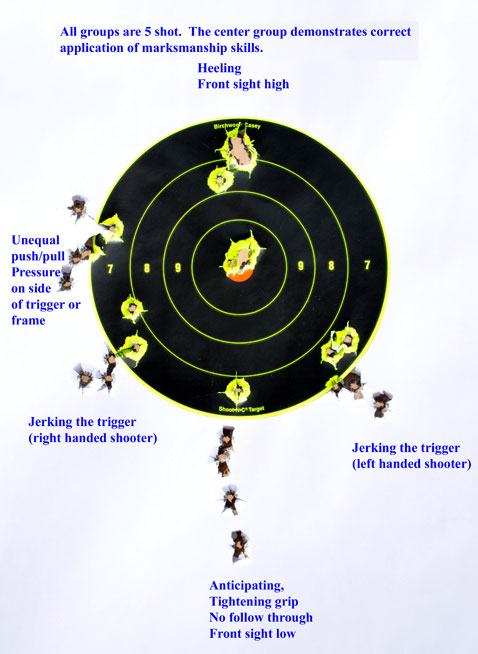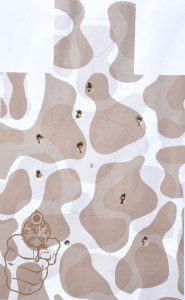Widgetized Section
Go to Admin » Appearance » Widgets » and move Gabfire Widget: Social into that MastheadOverlay zone
Training Tip – Reading The Target
In these parts it isn’t unusual to set aside the business at hand and talk about guns, especially if everyone knows you as the “gun guy”. I can hardly get through a doctor’s appointment, a trip to the store or a visit from the UPS driver without having a conversation about guns or shooting. And sometimes, I’ve been able to help people correct their shooting problems without even seeing them shoot. One time I was at the vet’s office to pick up some medicine for a sick critter when the doctor came out and we started talking about shooting. The doc wanted my advice on buying a new pistol and told me about his collection of high dollar 1911 pistols – all with adjustable sights. He said the sights had to be adjustable for his new pistol as well because, strange as it may seem, the sights on all his pistols were adjusted all the way up and way over to the right. He thought it was kind of odd that nobody made a pistol that shot where it was pointed without having to make major sight adjustments. I said, “Doc, I’ve never seen you shoot, but from what you’ve told me you’re a right handed shooter and you’re jerking the snot out of the trigger.” The doctor confirmed he was right handed but, of course, he denied being a trigger-jerker. To his credit, he agreed to come out to the range and we were able to fix his problem and re-zero all of his pistols.
One of the ways to improve your shooting is to work with a coach who knows his business but you can help yourself if you know how to read what the target is telling you. And, although I have seen countless cards and charts (and even an iPhone app) that claim to diagnose shooting errors, almost every one of them is based on one handed target shooting and doesn’t really work for two handed defensive pistol shooting. Here’s what the target might tell you if you’re shooting a pistol with two hands (and the sights aren’t completely out of adjustment).

Group low left or right
This is the classic trigger jerk; low left for a right-handed shooter and low right for a left- handed shooter. What happens is, as we watch the sights pass over the aiming point we tend to want to make the gun shoot NOW and we snatch at the trigger and pull the sights down and to the side. It’s a common error and one we all have to fight against. The cure lies in understanding that we can’t stop the sights from moving and if we pressss the trigger we’ll make our hits.
Group low
Shots clustered low of the aiming point can mean a couple of things. The first is failing to follow-through by lifting the head and the eyes from the sights as the shot breaks. We all want to see the hole appear in the target so we tend to look up and this moves the gun barrel down, resulting in low hits. Another cause can be holding the front sight low in the rear sight notch and yet another can be anticipating the shot. When we anticipate that the gun is going to fire we convulsively tighten our grip on the pistol and this pulls the barrel down. Try this: Point your finger gun at something across the room and focus on your finger. Tighten your thumb and your other three fingers and watch your “finger barrel” dip. Tightening your grip on the pistol does the same thing to the gun barrel so the cure for this one is to maintain a consistent grip on the pistol while only your trigger finger moves. Oh yes, and ignore the fact an explosion is about to take place in your hand. Focus on the front sight and pressss the trigger.
Group high
Shooting high can result from the front sight being too high in the rear sight notch and it can also be another form of anticipating the shot caused by pushing the hand into the pistol. We usually call this heeling because the heel or lower portion of the hand pushes up and elevates the gun barrel. Try this with your finger pistol and you’ll see your finger point up as you thrust the heel of the palm forward. When trying to shoot quickly from the holster it’s not uncommon for shots to go high because we get ourselves in a hurry and push through the aiming point. The cure for this one is to tell yourself to lock up at the top of the draw stroke and take a teeny, tiny pause before pressing the trigger while looking at the front sight.
No group
 All this target reading stuff doesn’t work if you can’t shoot a group. It doesn’t need to be a little one-holer but there has to be a group of some sort if we’re to make corrections. If the gun doesn’t seem to be grouping it’s usually not the fault of the gun or the ammunition (although we tend to blame these first) but the fault of the shooter. Why? Because we want to look at the target instead of aligning the sights and focusing on the front sight. Failing to group can be a combination of things like poor trigger control and looking at the target but most often it’s the fault of wanting to see those bullet holes while looking at the target. The cure for this one is to talk yourself into doing it right every single time you shoot. Your mantra should be, front sight, pressss.
All this target reading stuff doesn’t work if you can’t shoot a group. It doesn’t need to be a little one-holer but there has to be a group of some sort if we’re to make corrections. If the gun doesn’t seem to be grouping it’s usually not the fault of the gun or the ammunition (although we tend to blame these first) but the fault of the shooter. Why? Because we want to look at the target instead of aligning the sights and focusing on the front sight. Failing to group can be a combination of things like poor trigger control and looking at the target but most often it’s the fault of wanting to see those bullet holes while looking at the target. The cure for this one is to talk yourself into doing it right every single time you shoot. Your mantra should be, front sight, pressss.
Group left or right
As always, sight alignment can be a factor here but it might have to do with the way the pistol fits your hand; for example, a person with a little hand might have trouble keeping a pistol with a wide grip from squirming around as they press the trigger. Trigger finger placement is an important issue here, as too much or too little finger on the trigger can cause pressure to one side of the trigger or the other and this will move the barrel sideways. When shooting two handed we can pull or push the gun left or right by not having equal push/pull isometric pressure on the pistol and shooters who try to overpower the pistol by pulling back too hard with the support hand will pull the sights in that direction.
Feedback is an important part of learning and reading the target will give you the feedback to fix problems and improve your shooting. If you’re like my doctor friend and need a little help with your shooting I hope these tips can get you back in the X ring.
About the Author:
 Ed Head is a regular on Shooting Gallery, Gun Stories and Down Range TV. He has worked for almost 30 years in law enforcement, first in the United States Air Force and then with the United States Border Patrol, retiring as a Field Operations Supervisor. During his Border Patrol career, Ed worked in a variety of patrol, investigative and training capacities. Ed has an extensive background as a firearms instructor, having trained thousands, ranging from beginners to police, military and special operations personnel. Having taught at Gunsite for 20 years, Ed first trained there under the world famous shooting school’s founder, Jeff Cooper, then later ran the school as the operations manager for more than five years. Ed lives in Chino Valley, Arizona, where he continues to teach and write.
Ed Head is a regular on Shooting Gallery, Gun Stories and Down Range TV. He has worked for almost 30 years in law enforcement, first in the United States Air Force and then with the United States Border Patrol, retiring as a Field Operations Supervisor. During his Border Patrol career, Ed worked in a variety of patrol, investigative and training capacities. Ed has an extensive background as a firearms instructor, having trained thousands, ranging from beginners to police, military and special operations personnel. Having taught at Gunsite for 20 years, Ed first trained there under the world famous shooting school’s founder, Jeff Cooper, then later ran the school as the operations manager for more than five years. Ed lives in Chino Valley, Arizona, where he continues to teach and write.



 MidwayUSA
MidwayUSA Ruger Firearms
Ruger Firearms SCCY Firearms
SCCY Firearms Streamlight
Streamlight Action Targets
Action Targets Gunsite Academy
Gunsite Academy
One Response to Training Tip – Reading The Target
You must be logged in to post a comment Login